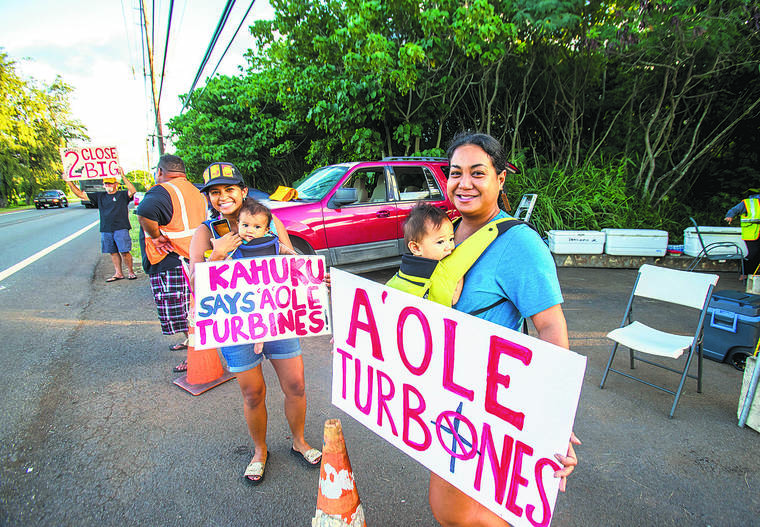Five miles away from the massive wind turbines in Kahuku, Dawn Bruns says she suspects her health is worsening due to the inaudible low-frequency sound waves coming from the machines.
“After the wind turbines were built, I noticed about once a month I would wake up at night with heart palpitations,” said the 49-year-old Sunset Beach resident. Several weeks ago she began jotting down how she slept when she noticed that every time the turbines were off, she “slept like a log.”
When near the turbines, she says she immediately starts feeling motion sickness and after a few hours gets a headache.
>> PHOTO GALLERY: Protesters arrested at Kalaeloa
>> PHOTO GALLERY: Protesters arrested in Kahuku Opens in a new tab
>> VIDEO: 55 arrested in wind-farm protests in Kahuku and Kalaeloa Opens in a new tab
“I only realize now this discomfort I feel … is from wind turbines. I think Kahuku will be uninhabitable if these wind turbines are allowed to operate,” said Bruns, who was the lead biologist in 2010 through 2012 for the permitting of three Maui wind farms for the U.S. Fish and Wildlife Service. “I never thought I was affected by them until (earlier this month) when I slept really well and noticed it was windless.”
Mark Miller, chief operating officer for AES Corp., the company that is adding eight turbines to the dozen windmills already in Kahuku, said extensive studies have determined the project to be safe for the community.
In addition, independent global and national research has consistently found “no evidence that wind farms cause any negative physical health effects,” neither have scientific peer-reviewed studies shown a direct link, he said.
But protesters in Kahuku who are experiencing health symptoms that include sleep disruptions, migraines, irritability and stress are becoming more alarmed about being near wind farms they believe are hazardous to their health. The new 3.45-megawatt turbines would be the largest ever built on land in the U.S., Bruns said. That compares with the already existing 2.5-megawatt turbines in Kahuku. The new project will be 0.3 mile away from Kahuku Elementary School and the closest residence and 0.1 mile away from farmers.
There is anecdotal evidence in communities across the country that “strongly suggests a connection between turbines and … symptoms including nausea, vertigo, blurred vision, unsteady movement, and difficulty reading, remembering, and thinking,” according to Environmental Health Perspectives, an independent peer-review journal published in 2014 by the National Institutes of Health, which also noted that peer-reviewed research on the potential impacts of wind farms is still unsettled. A year ago the World Health Organization added wind turbine noise in new guidelines for Europe to protect against excessive noise pollution, “one of the top environmental hazards to both physical and mental health and well-being.”
James Toma, noise supervisor for the Department of Health’s Indoor and Radiological Health Branch, said state officials are continuing to research possible health effects linked to wind farms, but so far “it really hasn’t been proven.”
”We haven’t found anything yet when it comes to infrasound. Even when you look at symptoms, a lot of symptoms can be from other things, too, not just the windmills,” he said. “To say that the windmills are causing it … scientifically it hasn’t really been proven yet. The thing with infrasound, too, is that anything that moves can generate infrasound, so like even with the ocean there’s a certain amount. Also wind. What’s hard is when you have so many potential sources … how do you say this is causing the infrasound that is the problem?”
Toma added that in communities that accept the windmills, “so-called health effects are much better than those that are against the windmills.” The Health Department will be examining decibel sound levels before and after the new windmills are installed to see whether there’s a difference, he said.
“It kind of depends on whether they want them or not,” he said. “That’s the hard thing about noise. Once you think you’re affected by it, irregardless, you’re going to tie things to it. It’s almost like a psychological thing.”
Kahuku resident Sunny Unga, 37, said the health effects are already being felt by many area residents and that adding more windmills will be “very detrimental” because “right now there are no laws that are in place to regulate infrasound, so there’s no protection for residential communities.”
“These wind turbines are detrimental to the health of our residents and our ecological systems. It has harmful adverse health effects on people. That’s an unfair burden to place on a small rural community and environmental injustice,” she said. “These companies come and continue to claim and deny that there’s no health effects, but that is not true at all. There’s communities worldwide from Germany, New Zealand, Australia and in the U.S. mainland that are being impacted and are experiencing detrimental health effects living near these wind turbines. It’s profit over people and profit over aina.”

